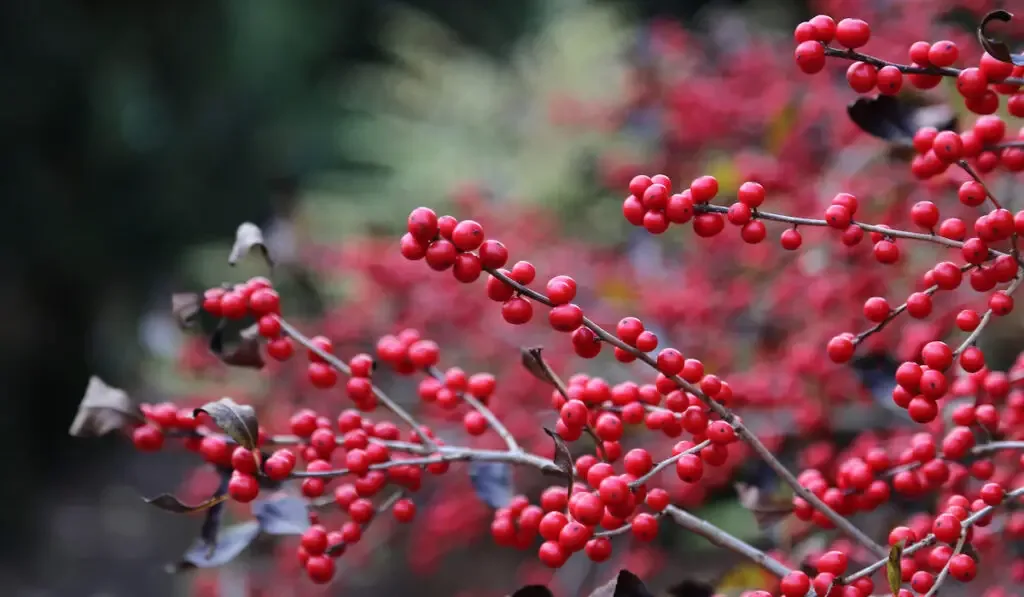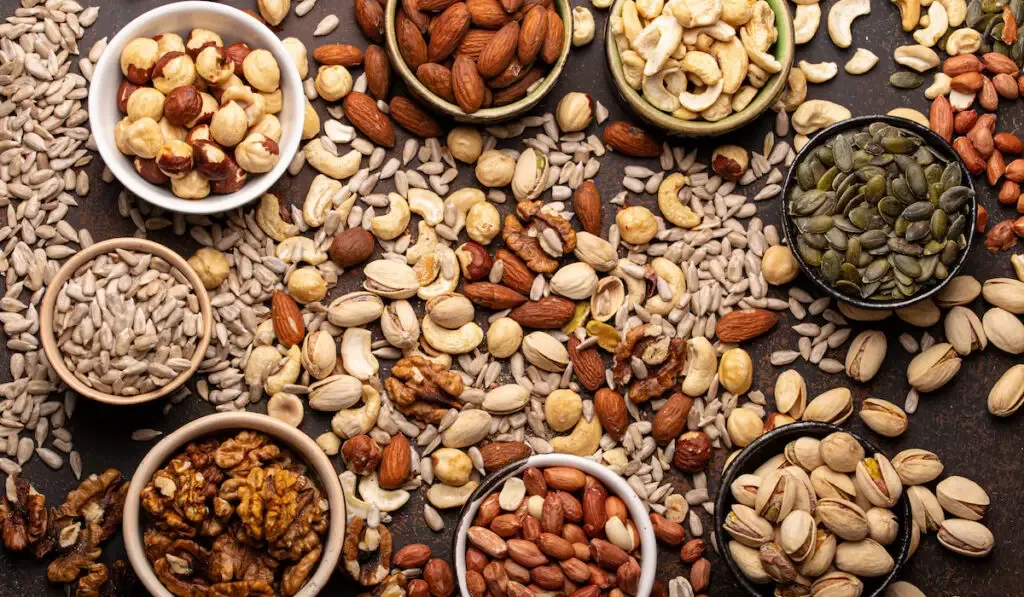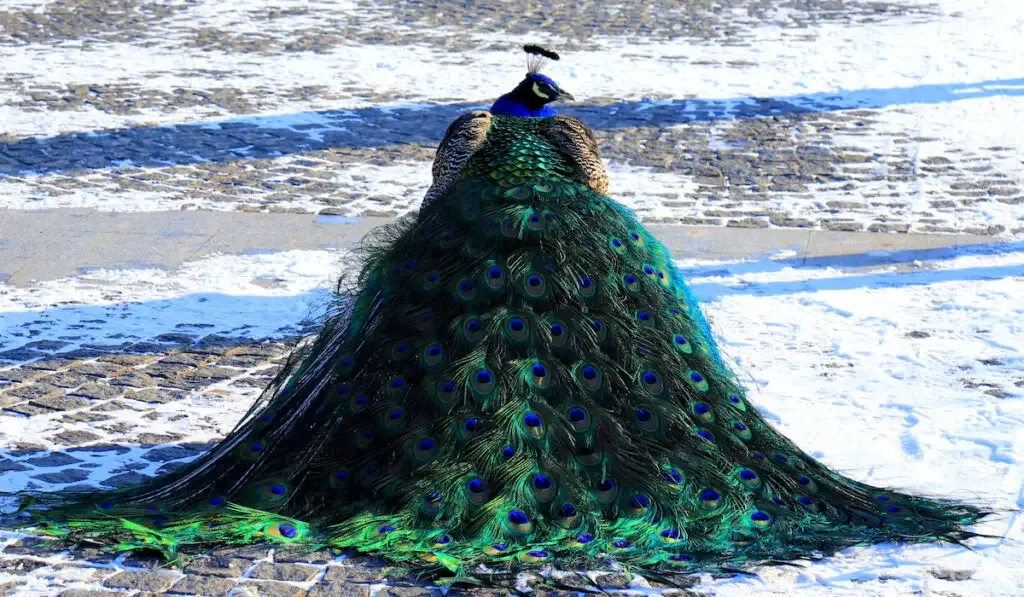Peacocks are beautiful birds. While it is common to see peacocks in zoos and other places, we don’t think much about wild peacocks. How do peacocks survive in the wild?
For instance, winter is coming. What do wild peacocks eat in winter? We should consider how these beautiful birds survive in winter.
Peacocks are native to tropical regions such as India, Cambodia, and Africa. This means that wild peacocks do not experience winter.
We should consider that it is possible that some domestic peacocks in temperate regions escaped to the wild. These peacocks can eat any food available such as winter berries, insects, seeds, and anything else they might find.
Table of Contents
Wild Peacocks in the Winter
It is not common to find wild peacocks in winter. This is because peacocks are native to tropical places and such regions do not have a winter season. If you find a peacock in the wild, it could be a pet peacock, or a farm bird that has escaped from its home.
Peacocks in places with winter are not native to those places.
What Wild Peacocks Will Likely Eat in the Winter
Since peacocks are not native to places in winter, we can only guess that if they are lost in winter, they will eat what other birds eat in winter. Some common foods for birds in winter are:
1. Winterberries

Winterberries are very popular amongst wild animals. Birds and mammals enjoy eating winterberries as they are both delicious and nutritious.
Winterberries keep a lot of bird species alive in winter.
2. Earthworms and Nematodes
If your peacocks scratch deep (and in the right place), they can find earthworms and nematodes. Peacocks love to eat these critters as they are both nutritious and delicious.
3. Amphibians (Toads)
It is very common to see peacocks and other birds eating toads, frogs, and other amphibians.
In winter, peacocks will mostly find toads on trees or holes as frogs will not go far away from their water source and may be hibernating.
4. Reptiles (Snakes and Lizards)
Peacocks search for every type of reptile including the active ones and the other hibernating species.
The active reptiles will be close to trees that peacocks roost in, so they can easily spot them.
5. Seeds and Nuts

Peacocks will eat whatever edible seeds and nuts that they can find. They can also eat newly germinated seeds. They search for and eat seeds from plants and also from the ground. In winter, wild birds eat whatever they can find.
As you can see, there are various food ideas for peacocks in winter. Remember that peacocks are not native to places with winter, so wild peacocks do not actually experience winter.
Related Questions and Answers
1. What Else Do Wild Peacocks Eat?
In the wild, peacocks are opportunistic feeders and will eat anything and everything that they can find.
Examples of items that peacocks eat in the wild are:
- Insects: Peacocks will search for and eat insects such as beetles, ants, moths, and others that they can find.
- Maggots: Insect maggots such as caterpillars, mealworms, grub worms, etc. are healthy and tasty treats for wild peacocks.
- Small Mammals: Wild peacocks will eat anything that cannot eat them. For example young rats, squirrels, etc.
- Fruits: Wild peacocks are omnivorous and can eat fruits. They can eat any fruit they can find and scientists have observed peacocks having a specific taste for the fruits in their area. This means that peacocks prefer fruits native to their region to fruits from other regions.
- Plant life: Foraged items such as leaves of trees and plants are also among the snacks of wild peacocks.
Wild peacocks eat tropical fruits, seeds, and little animals.
2. Are Peacocks Winter Hardy?

Peacocks may not be native to regions with winter, but they are winter hardy. The wings and plumage of peacocks help insulate their body in winter. Also, peacocks love to roost. Roosting peacocks have their legs far from the very cold snow, so they can survive fine.
So long as peacocks can have a shelter to run to and a steady supply of food in winter, they will survive fine.
3. How Do Pet Peacocks Survive the Winter?
If you are raising peacocks as pets or farm birds, here are tips to help them survive the winter:
- Provide a Large Coop: Peacocks need a shelter that they can run to when it is very cold outside. You should give them a roosting place in the coop so that they can roost as they love to.
- Insulate the Coop: You should insulate the coop by applying two or more layers of bedding and also blocking drafts. Also, make sure that at least one heat lamp is constantly switched on in the coop.
- Feed Your Peacocks with Grains: Grains such as wheat, maize, barley, and millet are useful in winter as they can keep your birds active and warm. Make sure that your peacocks have enough grains at night.
- Keep Your Peacocks Active: You can hang a green piñata in the coop. A green piñata is simply a hung fruit or vegetable that peacocks can peck on. This keeps them active and warm.
- Ventilate the Coop: Make sure that the coop is well ventilated as you do not want moisture to build up in the coop. The best way to ventilate the coop is to open the top windows. Make sure that there are no drafts at the bottom of the coop.
Remember to always watch your peacocks and make sure that they are safe.
4. Do Peacocks Change Colors of their Wings in Winter?

Peacocks do not change the color of their wings in winter. White peacocks are born white and they do not become white in winter. According to the breed, your peacock can be white, blue, green, opal, peach, etc.
Note that not all colors are found in wild peacocks (as some pet peacocks have their colors through selective breeding).
5. Should You Feed Wild Peacocks?
It is your choice to feed wild peacocks or not. Feeding peacocks will attract them to your home, so you should consider the amount of food you will give to them when they come.
Also, feed your peacocks with natural feeds such as seeds, grains, fruits, etc., and not processed feeds such as cheese, fried meat, and others. Do not feed your peacocks with human food.
Final Thoughts
Peacocks are not native to regions that experience winter, but if they are kept there, they can still survive winter as they are winter hardy. Their roosting behavior and thick plumage can help them survive winter.
In winter, wild peacocks will eat what other birds eat such as winter berries, little animals, seeds, and nuts.
Would you like to see a wild peacock in its natural habitat someday?
Sources
- https://animals.mom.com/what-kinds-of-foods-are-recommended-to-feed-peacocks
- https://petkeen.com/what-do-peacocks-eat-in-the-wild-and-as-pets
- https://askinglot.com/are-peacocks-winter-hardy
- https://kingwoodcenter.org/blog/have-you-ever-wondered-how-ducks-and-peafowl-survive-the-winter
- https://everythingwhat.com/what-do-you-do-with-peacocks-in-the-winter
